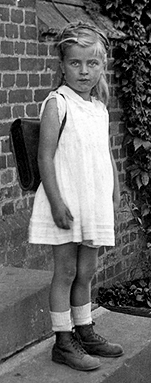Search for Names, Places and Biographies
Already layed Stumbling Stones
Suche
Liselott Kreidelmeyer * 1923
Am Frankenberg 8 (Harburg, Wilstorf)
HIER WOHNTE
LISELOTT
KREIDELMEYER
JG. 1923
EINGEWIESEN 1938
ALSTERDORFER ANSTALTEN
1943 "VERLEGT"
HEILANSTALT
AM STEINHOF / WIEN
ERMORDET 27.8.1943
Liselott Kreidelmeyer, born 19 June 1923 in Hittfeld, committed to the Alsterdorf Mental Institution, transferred to the Steinhof State Institution in Vienna, murdered there 27 Aug. 1943
Langenbek, Am Frankenberg 8
Liselott Kreidelmeyer was the third of seven children. Her parents were Franz and Erna Kreidelmeyer. She spent the first years of her childhood in Emmelndorf near Hittfeld. Her father was a ship’s captain, and worked for the HAPAG (Hamburg-Amerikanische-Paketfahrt-Actien-Gesellschaft) as a tallyman at the Port of Hamburg. For many years, Liselott was the most lively child in the family.
For the carefree child and her parents and siblings, the world fell apart when Liselott contracted meningitis shortly after she started school. It caused permanent brain damage. Life in the home changed dramatically, since Liselott required more care than the other children. In the late 1920s the family moved to Hamburg, where they first lived on Dürerstraße (present-day Flebbestraße) and then at Am Frankenberg 8.
With her happy nature and childish charm, Liselott was a delightful child. She played games and sang whenever and wherever she could. She knew nearly every children’s song there was to know. Her favorite activity was helping her mother in the garden. She knew what plants needed and what they were called. She especially liked to pick healing herbs. Her parents and siblings supported her. Even though she went to a different school than her friends, they accepted her without reserve, as did the people in the neighborhood. The relationship to her parents became even closer when the little girl began to suffer from epileptic seizures. Nighttime was especially bad – she often had several seizures per night, which caused her to scream loudly in pain.
Even after several longer stays in the Harburg-Wilhelmsburg State Hospital and in the Eppendorf University Medical Center, her health did not improve. Each time she was in the hospital, her parents had her released before her treatment was successfully completed. The situation in the family came under more and more strain, and the intensive care for the sick child exhausted her mother. In 1937, the Youth Welfare Office suggested that she be admitted to the Alsterdorf Mental Institution, for the good of everyone concerned. Although it was difficult for her parents, she was admitted on 1 September 1938.
It seemed to be a good decision, since Liselott Kreidelmeyer developed well in the Institution. After only three months the doctors and staff determined: "[The young patient] shows interest in her surroundings, and is curious about everything. She likes to look at picture books and reads aloud from them to the other children. She always has a good appetite.” Her parents and siblings visited often, and she sometimes spent holidays at home, so she likely had the feeling that she was still part of the family and that she would one day return to live with them. But after some time in the institution, the epileptic seizures returned, with increasing frequency.
All hopes for a positive change were dashed in the end. Liselott Kreidelmeyer was among the 496 patients who were ‘evacuated’ from Hamburg in August 1943, at the initiative of Pastor Friedrich Lensch, the director of the Alsterdorf Institution, in close cooperation with the Hamburg Office of Public Health.
On 16 August 1943, the 20-year-old Liselott Kreidelmeyer, along with 227 other girls and women from Alsterdorf, were transferred to the Steinhof State Institution in Vienna. There, Liselott’s epileptic seizures became more severe. She had a particularly severe seizure on 27 August 1943, and she was declared dead the next day. On the death certificate, the cause of death was listed as "falling sickness” (epilepsy). It is not out of the question that the ashes in the urn returned to her parents (at their own expense) were not actually hers.
Translator: Amy Lee
Kindly supported by the Hermann Reemtsma Stiftung, Hamburg.
Stand: October 2016
© Klaus Möller
Quelle: Gedenkbuch der Evangelischen Stiftung Alsterdorf; Gespräch des Verfassers mit Klaus und Ruth Kreidelmeyer vom 30.6.2011; Wunder u. a., Kein Halten, 2. Auflage.


